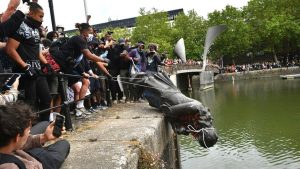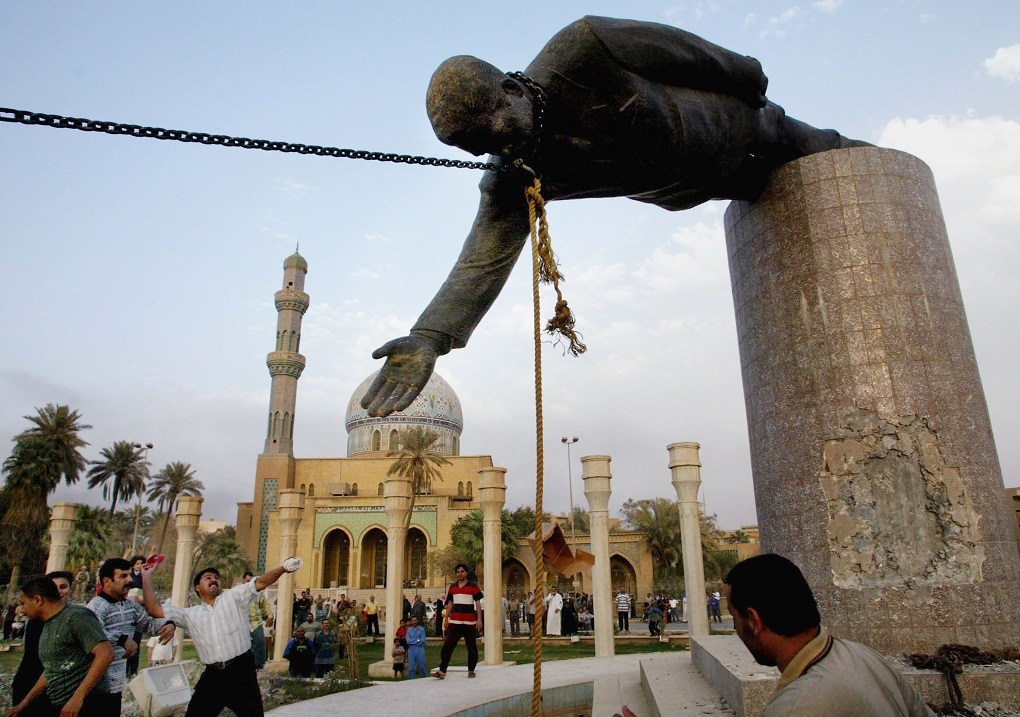Statues have been torn down for almost as long as they have been raised, but it was only in 2020 that Belgium’s Leopold II statues were seriously in danger of being ripped from their plinths.
In 2020, there was a worldwide wave of iconoclasm: attacking statues. Damaging or destroying statues as a political act has accompanied such historical events as the French Revolution, the English Reformation, and the fall of communism. What was new in 2020 was the global scale.
Following the killing of George Floyd and the #BlackLivesMatter protests in the United States, statues were attacked in North and South America, Europe, parts of Asia and Africa, and Australasia. The targets were mostly connected to themes of racial injustice. In Brussels, the focus was on images of King Leopold II.
Leopold’s bust in Ghent was covered in red paint and half of its face was knocked off. His statue in Antwerp was set on fire. In Brussels, thousands protested at the landmark equestrian statue of Leopold: it too was doused in red paint, and protesters climbed it, flying a Congolese flag.
Shortly after the protests, the Brussels regional government set up a working group to look at the decolonisation of public space, an approach that aimed at a more orderly process of change.

The defaced statue of General Robert E. Lee, Richmond, Virgina.
Some authorities worldwide have already taken similar action. In Richmond, Virginia, the equestrian statue of Confederate general Robert E. Lee was lifted off its plinth and carted away in September 2021.
By contrast, in Britain, the government itself has led a backlash against statue protests. It is currently proposing a new law to punish anyone who damages a memorial – regardless of the cost of repairing the damage – with ten years’ imprisonment.
The same arguments about statues tend to recur everywhere. Are they a form of art that is barbaric to destroy, or a form of propaganda that is barbaric to leave up? There is anger about “erasing history” on one side, and anger about glossing over the historical roots of modern injustice on the other.
Any individual’s position on these questions tends to depend – as it should – on which statues are under discussion. Few would dispute that East and West Germany were right to destroy all Nazi statuary after World War II.
In the case of Leopold II, the man himself, his legacy and his monuments have always been controversial. During his own lifetime, Leopold became a pariah, criticized for his brutal administration of the Congo Free State by figures including Booker T. Washington, Arthur Conan Doyle and Mark Twain. Over the last century, statues of Leopold have gone up, come down, gone up again, and come down again.
The bizarre twin Leopold statues
The equestrian statue of Leopold in Brussels is one of a pair. It was put up in 1926, 17 years after his death, by his nephew and successor King Albert I. Albert also unveiled its twin in 1928 in Léopoldville, Belgian Congo (now Kinshasa, Democratic Republic of Congo).
Following the trauma of the First World War in Belgium, these statues were part of a deliberate campaign to rehabilitate Leopold’s reputation – and entrench support for the monarchy. This campaign was successful for a while.

King Leopold's statue in Kinshasa at the National Museum of Congo
But during the process of Congolese independence, cracks began to appear. Patrice Lumumba, Congo’s first prime minister after independence in 1960, was sharply critical of the Belgian monarchy’s colonial history. The statue of Leopold in Kinshasa was pulled down by Mobutu Sese Seko’s administration in 1966 and dumped behind a shed.
In Belgium, too, academic historical attention returned to the colonial past. In 1998, the American historian Adam Hochschild, building on decades of Belgian scholarship, published ‘King Leopold’s Ghost’, a devastating account of Leopold’s private empire. It became an international bestseller.
As it had in his lifetime, the mood started to turn against Leopold. In 2004, Leopold’s statue in Ostend was altered by a group called De Stoeten Ostendenoare (The Bold Ostenders). The monument includes a group of supplicatory Congolese figures: the hand of one of these was removed, to memorialize the many Congolese people whose hands had been hacked off for failing to fill Leopold’s rubber quotas.
In 2006, a chain was put around the neck of the Leopold statue in Ekeren. It was splashed with red paint in 2007 and 2009. As for the equestrian statue in Brussels, one activist staged a “symbolic hanging” of it in 2008, with yet more red paint.

One of many Leopold II busts defaced in Belgium
Meanwhile, in the Congo, the equestrian statue of Leopold had a bizarre revival. On February 3, 2005, it was retrieved from behind the shed and put back up on a pedestal in Kinshasa. This had been done on the orders of Christophe Muzungu, the country’s Culture Minister, who argued that colonial statues were an important part of Congolese heritage.
The Congolese public disagreed. Within hours, an angry crowd formed. The authorities lost their nerve: Leopold was pulled down again. This time, his statue had stood for less than a day. It was later discreetly moved to the grounds of the National Museum.
What can you do with an unwanted statue?
Now it’s the turn of Brussels and its working group on decolonisation to figure out what to do with their version of this highly contentious object. There are some intriguing precedents around the world, many far more creative than the humdrum option of adding an apologetic plaque.
In Moscow, Budapest and Delhi, statues have been moved to outdoor sculpture parks – or ‘statue graveyards’ – which become extraordinary, haunting reminders of fallen regimes. Some monuments have been imaginatively altered: one Lenin statue in Ukraine was transformed into Darth Vader, his overcoat becoming a billowing cloak.

Protesters pull down a statue of slave trader Edward Colston, Bristol, England.
The statue of slave trader Edward Colston that was dramatically pulled down in 2020 is currently on display in Bristol, England, complete with graffiti and protest signs. A statue of Kwame Nkrumah that was beheaded in Ghana’s 1966 coup now stands in Accra with its severed head on a separate plinth next to it. An altered or damaged statue may tell a story at least as powerful, if not more powerful, than the original monument.
Historical facts do not change, but – as we can see from the rollercoaster of Leopold’s reputation – the ways we remember and commemorate our history change all the time.
Statues are not a record of history, but of historical memory. It is a sign of a healthy public discourse that every generation will reassess this. From a historian’s point of view, one positive effect of the debate in Brussels is that more people are talking and learning about the history of Belgium and the Congo. Whatever happens to Leopold’s monuments, history itself is not being erased. But it may be remembered and understood more clearly than ever.

